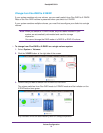
Volume Configuration
20
ReadyNAS OS 6.1
X-RAID2
X-RAID2 is an auto-expandable RAID technology that is available only on ReadyNAS
systems. With X-RAID2, you do not need to know intricate details about RAID to administer
your system. X-RAID2 allows you to add storage space without reformatting your drives or
moving your data to another location. Because the expansion happens online, you can
continue to use your ReadyNAS system while the volume capacity increases.
Because X-RAID2 is a single-volume architecture, if you configure your hard disk drives to
use X-RAID2, your storage system has only one volume that is made up of all installed hard
disk drives. X-RAID2’s single-volume architecture has two major advantages:
• Easy system management
• Auto-expansion
With Flex-RAID formatting, if you want to add disks to expand your storage capacity, you
must back up the data to another system, add a disk, reformat the RAID volume, and restore
the data to the new RAID volume. With X-RAID2, none of those administrative tasks are
required. Instead, with X-RAID2, your volume automatically expands to accommodate
additional disks or larger-capacity disks.
With X-RAID2, you can start out with one hard disk, add a second disk for data protection,
and add more disks for additional storage capacity. X-RAID2 accommodates the new disks
automatically. You can replace existing disks with larger-capacity disks and X-RAID2
automatically accommodates the new disks.
X-RAID2 requires a minimum of two hard disks to provide protection against disk failure. If
you have a one-disk ReadyNAS storage system and want protection from disk failure, you
must add a second disk that is at least as large as the first. It can be added while the system
is running.
X-RAID2 uses the capacity of one disk for data storage and reserves the capacity of a
second disk for data protection, which allows the volume to recreate data if a disk fails. In a
two-disk system, the usable storage space is one disk. In a three-disk system, the usable
storage space is two disks. In general, the total capacity of your storage system equals the
capacity of all your disks minus the capacity of one disk.


















